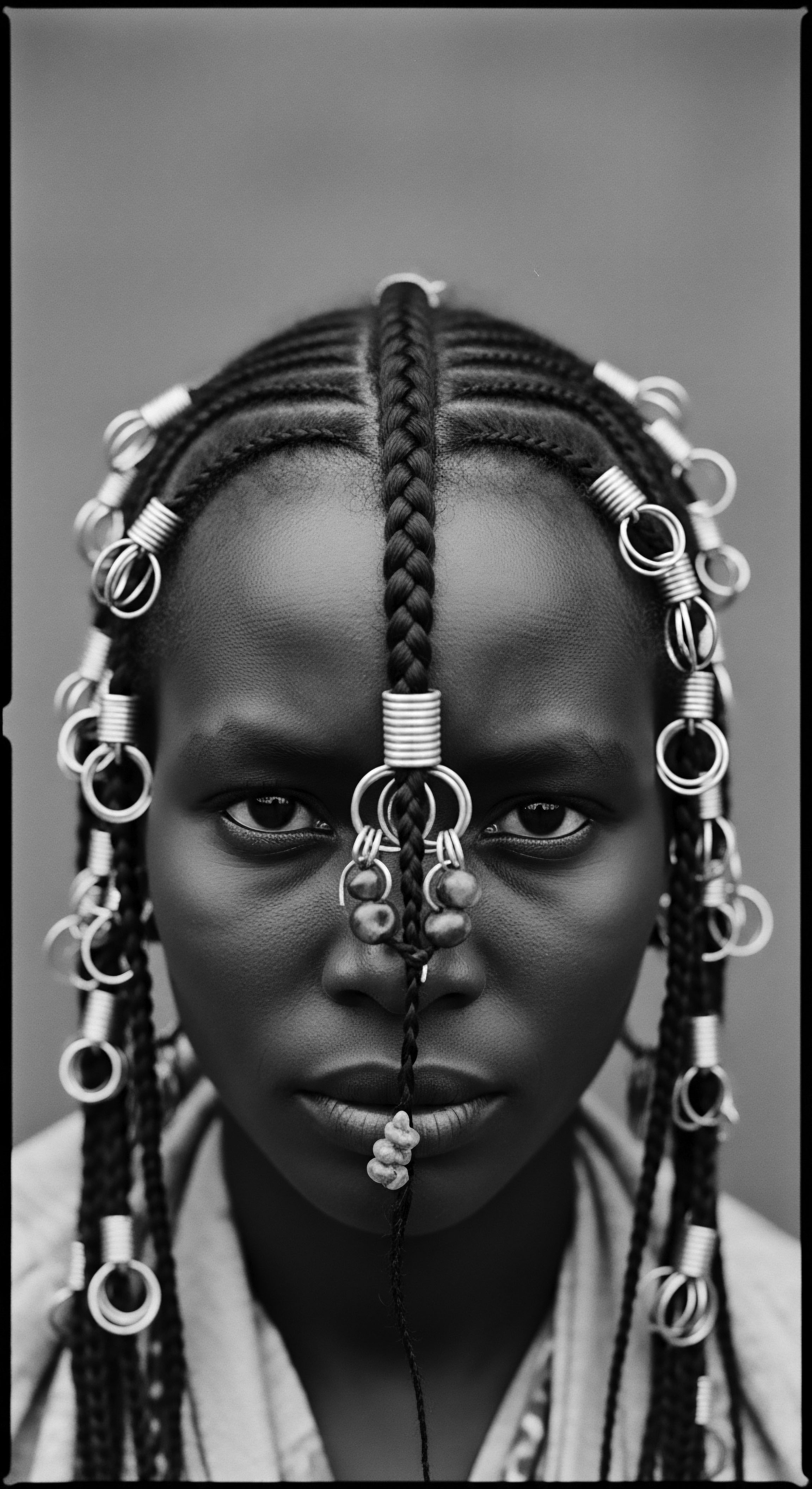
Roots
Consider for a moment the profound resonance carried within a single strand of textured hair. It holds not merely proteins and keratin, but echoes of generations, a living archive of resilience and beauty. In this spirit, we turn our gaze to the shea tree, Vitellaria paradoxa, standing ancient and steadfast across the savannah belt of West and Central Africa. For centuries, its humble nuts have yielded a golden bounty, a substance known with deep reverence as Women’s Gold.
This is not simply a name bestowed for its hue or worth, but a recognition of its ancestral place within African communities, particularly its deep connection to the hands and lives of women. The processing of shea butter, a practice stretching back millennia, serves as a testament to indigenous ingenuity and economic autonomy, woven deeply into the very fabric of textured hair heritage.
Shea butter processing stands as a living testament to ancestral ingenuity, creating a tangible link between generations of African women and their deeply rooted heritage.

The Shea Tree’s Ancestral Place
The shea tree holds a sacred position in many West African cultures. It thrives in the dry, unforgiving climate of the Sahel, offering sustenance and solace. Oral histories often recount the shea tree as a Gift from the Gods, underscoring its spiritual and ecological significance. Communities observe customs that emphasize respect for nature, even prohibiting the felling of these trees.
The connection is intimate, almost familial. The shea fruit, plum-like in appearance, takes months to ripen, falling naturally to the earth, signaling the start of the harvest season. This quiet cycle of nature, honored for generations, forms the initial bond between women and this ancestral resource.
From ancient Egypt, tales suggest figures like Queen Nefertiti and Cleopatra relied on shea butter, transporting it in clay jars to protect and nourish their skin and hair in harsh desert conditions. This long history establishes shea butter not merely as a commodity but as an integral part of African culture and traditions, a symbol of fertility, protection, and purity. Its use in hair care, specifically for textured hair, is not a modern discovery; it has been a foundational practice for centuries, deeply embedded in routine and ritual.

Handcrafting Gold Traditional Methods
The traditional method of extracting shea butter is a labor-intensive endeavor, primarily undertaken by women, yet it is this very dedication that preserves its purity and traditional value. The journey from nut to butter is a communal legacy, passed down through the generations, mother to daughter, fostering collective participation and the sharing of indigenous knowledge.
The process begins with the careful collection of fallen shea nuts. These are then dried under the sun, a natural process that prepares them for the next stage. Next, the nuts undergo roasting, which helps in increasing their oil yield and develops their characteristic nutty aroma. Following roasting, the nuts are pounded and ground into a fine paste.
This paste is then meticulously kneaded by hand with water, a painstaking step that separates the butter from the solid components. The extracted fat is then gently heated to remove impurities, allowing the pure shea butter to rise to the surface, where it is skimmed off and left to cool into its creamy, solid form. This artisanal process, though demanding, ensures a nutrient-rich, unrefined butter, retaining its vitamins A, E, and F, alongside essential fatty acids, all crucial for skin and hair health.
- Harvesting ❉ Gathering naturally fallen shea nuts, a communal activity often accompanied by songs and stories.
- Drying ❉ Spreading nuts under the sun to prepare them for processing.
- Roasting ❉ Heating nuts to enhance oil yield and deepen their aromatic qualities.
- Grinding and Kneading ❉ Pounding nuts into a paste, then mixing with water and hand-kneading to separate the butter.
- Boiling and Filtering ❉ Heating the extracted fat to purify it, followed by cooling and solidification.

How Ancient Knowledge Meets Modern Understanding of Hair
The ancestral wisdom embedded in shea butter processing aligns remarkably with contemporary scientific understanding of textured hair needs. Textured hair, with its unique coil patterns and cuticle structure, often requires intense moisture and protection to thrive. Shea butter’s composition, rich in vitamins and fatty acids, provides exactly this, sealing moisture into the hair shaft and guarding against environmental stressors.
This is not a coincidence; it reflects generations of observation and practiced efficacy. The long-standing use of shea in hair rituals demonstrates an intuitive grasp of hair science, centuries before laboratories could analyze its molecular structure.

Ritual
The hands that process the shea nut into its golden butter are the same hands that have, for generations, cared for and styled textured hair. The intimate connection between shea butter and hair is not merely functional; it is ceremonial, a living ritual passed down through ancestral lines. In African societies, hair is a profound identifier, signifying age, marital status, social rank, and even family lineage.
It serves as a visual language, a canvas for storytelling, and a connection to cultural identity. Shea butter, often applied during hours-long styling sessions, becomes part of this communal and expressive heritage, deeply grounding Black and mixed-race experiences in shared traditions.
Shea butter links hair care to communal rituals, deepening its role in textured hair heritage and fostering shared identity across generations.

Hair as Identity, Shea as Sustenance
Hair care traditions in Africa historically represent much more than simple grooming. They are moments of bonding, intergenerational teaching, and cultural expression. The intricate braiding styles, often taking hours or even days, created a shared space for women, a time for storytelling and community building. Shea butter was a constant companion in these sessions, providing the essential moisture and pliability needed to create and maintain elaborate styles such as cornrows, twists, and locs.
It aided in length retention, protected strands from harsh climates, and contributed to the overall health and vitality of the hair. The consistency of shea butter made it an ideal base for mixing with other natural ingredients, like Chébé powder, as practiced by Chadian women to hydrate and seal hair.
This cultural integration of shea butter into hair care extends beyond West Africa. Across the continent, from Himba women in Namibia using ochre, goat hair, and butter for their distinctive dreadlocks, to Ethiopian tribes using clarified butter (ghee) for moisturizing and strengthening hair, the principles of using natural fats to protect and adorn hair hold true. The universal presence of shea butter in these diverse traditions speaks volumes of its effectiveness and enduring place in ancestral beauty practices.

The Shaping Hand and the Softening Balm
The applications of shea butter in textured hair care are diverse, reflecting centuries of practical application and refinement. It serves as a deep conditioner, a sealing agent, and a protective balm. Its richness provides intense hydration without leaving a greasy residue, a quality highly valued in hot, dry climates. The butter’s ability to protect skin from sun, wind, and dust translates seamlessly to hair, shielding strands from environmental aggressors.
The rituals of care often involved warming the butter slightly to enhance its spreadability, then massaging it into the scalp and along the hair strands. This process not only distributed the product but stimulated the scalp, promoting a healthy environment for hair growth. For many, this was a weekly or bi-weekly ritual, a sacred time dedicated to nurturing their crown. The act of applying shea butter, often with rhythmic movements, became a meditative practice, reinforcing the connection between self-care and ancestral wisdom.
| Traditional Hair Use Scalp Invigoration ❉ Massaged directly onto the scalp to soothe and condition. |
| Modern Application (Heritage Link) Pre-Poo Treatment ❉ Applied before shampooing to protect hair from stripping and add moisture. |
| Traditional Hair Use Styling Balm ❉ Used to soften hair for intricate braids, twists, and dreadlocks, aiding pliability. |
| Modern Application (Heritage Link) Leave-In Conditioner ❉ Worked into damp hair to provide lasting moisture and styling hold for coils. |
| Traditional Hair Use Environmental Shield ❉ Applied to protect hair from sun, wind, and dust in dry climates. |
| Modern Application (Heritage Link) Heat Protectant ❉ A natural barrier against thermal damage during gentle heat styling. |
| Traditional Hair Use Hair Strengthening ❉ Utilized to reinforce strands and promote overall hair health. |
| Modern Application (Heritage Link) Deep Conditioning Mask ❉ Blended with other ingredients for intense repair and nourishment. |
| Traditional Hair Use The enduring utility of shea butter for textured hair remains a constant across time, honoring ancestral methods within contemporary routines. |

Communal Braiding and Shared Wisdom
The creation of elaborate hairstyles often took place in communal settings, where women gathered, sharing stories, laughter, and the wisdom of their elders. These sessions were informal schools, transmitting not only styling techniques but also the deep cultural meaning behind each braid, each twist. Shea butter, as a staple in these gatherings, facilitated the artistic expression and physical labor involved.
The act of one woman braiding another’s hair, with shea butter as the medium, created intimate bonds, reinforcing social structures and fostering a sense of collective identity. This shared experience, deeply rooted in ancestral practices, speaks to the strength of community and the power of heritage in shaping personal and collective narratives.

Relay
Beyond its esteemed place in beauty rituals and ancestral care, shea butter processing acts as a powerful catalyst for change in the lives of African women. It stands as a vital economic engine, predominantly controlled by women, securing livelihoods and fostering independence across the shea belt. The journey of the shea nut, from wild harvest to marketable product, is a relay race of sorts, passed through the skilled hands of women who convert this natural resource into tangible economic and social agency. This process, often referred to as a pathway to Women’s Economic Empowerment, reaches far beyond individual earnings, extending into household decision-making, community development, and the preservation of a precious cultural inheritance.
Shea butter processing provides a substantial income source for millions of African women, bolstering economic agency and challenging traditional power dynamics within their communities.

Economic Sovereignty and Women’s Hands
The economic impact of shea butter processing is substantial. Estimates suggest that between 3 million and 16 million women across West Africa are involved in the shea sector, collectively generating a significant income from the sale of nuts and butter exports. This revenue, often earned during lean agricultural seasons, becomes a critical financial buffer for families, used for essential household expenses like food, health insurance, and children’s school fees. For many women, this represents their primary source of personal income, providing a rare pathway to financial independence in contexts where traditional economic roles might limit their opportunities.
Consider the findings from a study in Nigeria by Okolo, Omorogbee, and Alufohai (2016). This research found that women involved in shea butter production in the north central states of Nigeria produced an average of 3,691 kilograms of shea butter annually, translating to an average individual income of approximately ₦43,031. The study further indicated that nearly 70% of these women relied on personal savings as their main source of funding for production, underscoring their self-reliance and the direct agency they exert over their economic activities. This direct involvement in the production and marketing process empowers women with a sense of ownership and control over their work.
| Region Niger State |
| Average Annual Shea Butter Output (kg) 4,811.75 |
| Average Annual Individual Income (₦) 47,861.86 |
| Region Nasarawa State |
| Average Annual Shea Butter Output (kg) 2,582.47 |
| Average Annual Individual Income (₦) 38,958.33 |
| Region These figures underscore the tangible economic gains for women in the shea sector, with regional disparities highlighting areas for further support. |

Beyond the Jar Social Change
The impact of shea processing stretches beyond mere financial gain, extending into significant social transformation within communities. As women gain financial autonomy, their voices carry greater weight in household decision-making, challenging traditional power dynamics within the family unit. They are increasingly consulted in village meetings and gain respect for their contributions to family farms and community economies. This shift represents progress in addressing gender inequality, placing resources and incomes directly into the hands of the women who produce them.
Women’s cooperatives play a crucial part in this social change. These groups not only pool resources and facilitate market access but also serve as platforms for skill acquisition and collective action. Organizations such as the United Nations Development Programme (UNDP) and Tree Aid have supported these cooperatives by providing modern machinery, which significantly reduces the arduous manual labor traditionally involved in shea butter production.
For instance, with appropriate technology, women in Ghana have been able to increase their production from one bag of shea butter per week to ten bags a day, simultaneously improving product quality and reducing the health risks associated with manual processing. This modernization respects ancestral practices while enhancing efficiency and well-being.
- Increased Income ❉ Direct revenue for women from shea product sales.
- Enhanced Decision-Making Power ❉ Greater influence in household and community matters.
- Skill Development ❉ Acquisition of new production and business skills through cooperatives.
- Improved Health ❉ Reduction of labor-intensive manual processes through technological support.
- Cultural Preservation ❉ Economic value helps maintain the traditional knowledge and practices associated with shea.

Looking to Tomorrow, Guided by Yesterday
Despite the clear benefits, challenges persist for women in the shea industry, including limited access to financing, insufficient modern equipment, and inconsistent market access. Organizations continue to work toward strengthening the entire shea value chain, ensuring fair compensation and opportunities for growth. The story of shea butter processing is therefore not static; it is a continuing journey of resilience, adaptation, and empowerment.
It demonstrates how traditional knowledge, when supported and valued, can become a powerful force for economic development and social justice, all while preserving a rich cultural heritage. The future of shea butter, and the women whose lives are inextricably linked to it, is a testament to the enduring strength found in ancestral roots.

Reflection
The story of shea butter, from its deeply rooted origins in ancestral soil to its continuing journey across continents, is a profound meditation on textured hair, its heritage, and its care. It speaks to something far older and more resonant than commerce alone. Each pot of shea butter, handcrafted by women across the Sahel, carries the spirit of generations—their knowledge, their songs, their collective strength. It is a living, breathing archive of Black and mixed-race hair traditions, where the very act of processing connects the past to the present, forming an unbroken lineage of care.
The “Soul of a Strand” finds its truest expression in this golden offering, a testament to how the land provides, how wisdom is passed, and how the hands of women sustain not only their families but also a legacy of beauty that refuses to be diminished or forgotten. This continuing saga of shea butter is a quiet revolution, unfolding daily, affirming the profound connection between an ancient tree, the women who tend it, and the rich, resilient heritage of textured hair across the globe.

References
- Alhassan, I. (2016). Impact of Shea Butter Processing on Household Basic Needs in Selected Districts of the Northern Region of Ghana. Journal of Agricultural Extension, 20(1), 143-157.
- FAO. (2012). The impact of the shea nut industry on women’s empowerment in Burkina Faso. FAO Knowledge Repository.
- Oakley, G. (2022). Women’s gold ❉ What the coffee industry can learn from shea butter production. Perfect Daily Grind.
- Okolo, C. C. Omorogbee, F. E. & Alufohai, G. E. (2016). Income Generation from Shea Butter Production by Women in North Central States of Nigeria. Journal of Agricultural Extension, 20(1), 27-37.
- Tree Aid. (n.d.). How is shea butter helping women’s empowerment in African drylands?
- UNDP. (2022). Restoring resilience of women in shea. United Nations Development Programme.
- Ciafe. (2023). Shea Butter – Explainer.
- Thirteen Lune. (n.d.). Discovering the Cultural Heritage of Shea Butter.
- Graham Sustainability Institute. (2024). Empowering Ghanaian Women Shea Farmers through Diverse Entity Types.
- Sellox Blog. (2025). Reclaiming Ancestral Beauty Practices.
- Paulski Art. (2024). The Rich History of Shea Butter and Its Origins.
- Beauty Garage. (n.d.). Shea Story.
- Bebrų Kosmetika. (2024). The Power of Hair in African Folklore ❉ Rituals and Traditions.
- Hale Cosmeceuticals. (2024). Fair Trade Shea Butter ❉ Embracing Sustainable Beauty.
- Kumar Metal Industries. (n.d.). How shea butter is made ❉ A complete guide to shea nut processing.
